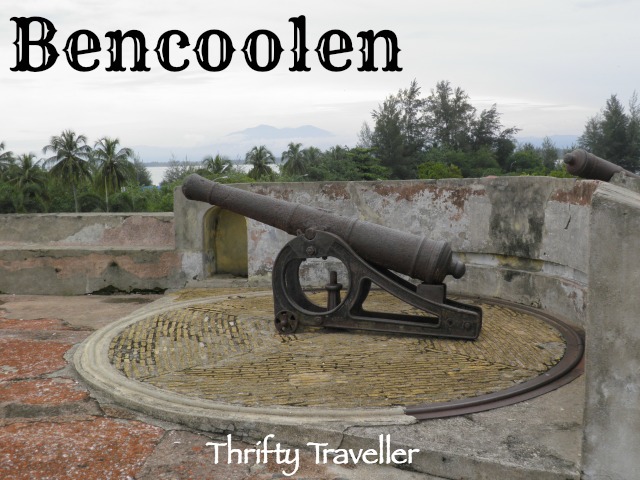
“This is without exception the most wretched place I ever beheld. I cannot convey to you an adequate idea of the state of ruin and dilapidation which surrounds me.”
So said Stamford Raffles when he arrived in Bencoolen to take up the post of Governor General in October 1817.
A bit harsh? Probably not at the time. Even today, after 200 years of progress, an air of torpor hangs over the old part of Bencoolen, the part that Raffles would recognise, though to be fair the town (now called Bengkulu) has grown enormously and the newer districts are more vibrant.
By the time Raffles arrived, Bencoolen had already been a British possession in Sumatra for 132 years, having been established as an East India Company (EIC) trading post in 1685, reporting to the Bengal Presidency.
A combination of rampant malaria, depressingly damp climate, lazy and corrupt officials, economic mismanagement, earthquakes and a local population unwilling to toil unnecessarily for foreign masters meant that Bencoolen was one of Britain’s least successful colonies.
Raffles had just arrived from a successful stint in Java and despite his negative first impression of Bencoolen he set about making a go of it with his customary talent and energy. He abolished slavery and gambling, he planted nutmeg and coffee, freed up the pepper trade and repaired strained relations with local chiefs.
Eventually however even Raffles was worn down by Bencoolen. The nutmeg and coffee crops were losing money and four of his children died here from fever, presumably malaria, which almost took his life too. Gradually his attention shifted towards a new settlement that he had established on a small island called Singapore which he saw as having greater potential.
Bencoolen was soon afterwards handed over to the Netherlands as part of the Anglo-Dutch Treaty of 1824 in exchange for giving up any Dutch claim to Malacca and Singapore. The Dutch East India Company may have been master traders but they were less canny when it came to swapping territories. Not only did they swap Bencoolen for Singapore, the Dutch wanted the tiny nutmeg growing island of Run so badly that they exchanged it for New York! Of course I am over-simplifying.
On my recent trip to Bengkulu I looked for the remnants of British Bencoolen together with any other tourist sights. Here is what I found.
Fort Marlborough
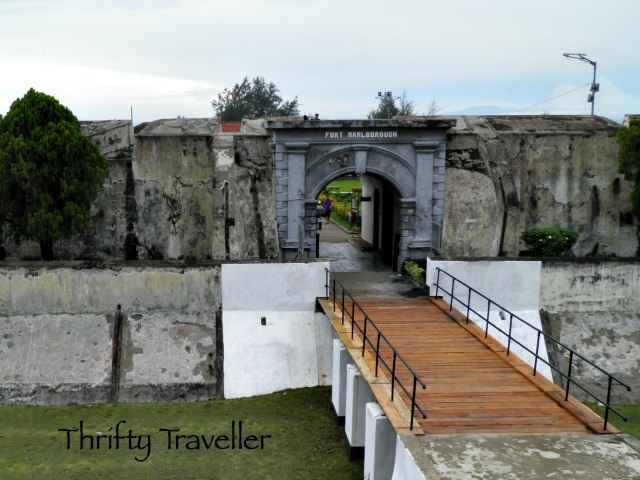
Bencoolen’s top British relic is undoubtedly Fort Marlborough which was built by the East India Company between 1714 and 1720. It replaced an earlier fort called Fort York which had been built in the wrong place and was later abandoned. Despite its age and its location in an earthquake prone area Fort Marlborough remains in remarkably good condition with thick, robust walls arranged in a star shape and surrounded by dry moats.
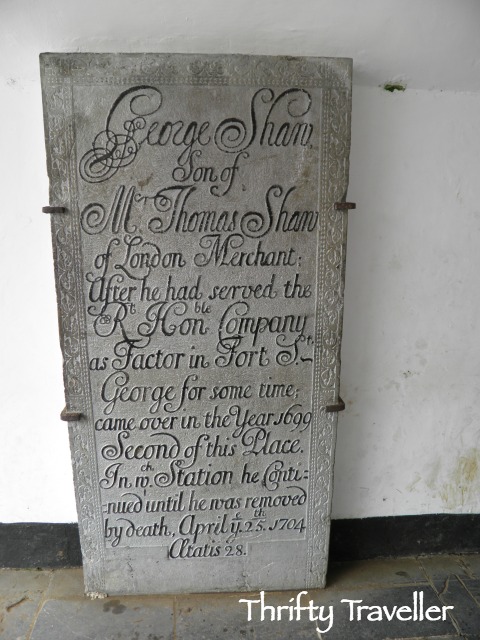
Three large tombstones are propped up against a wall just inside the entrance. This one remembers George Shaw who served as a factor in Bencoolen from 1699 until he was ‘removed by death’ in 1704. The other headstones are of Richard Watts and Henry Stirling.
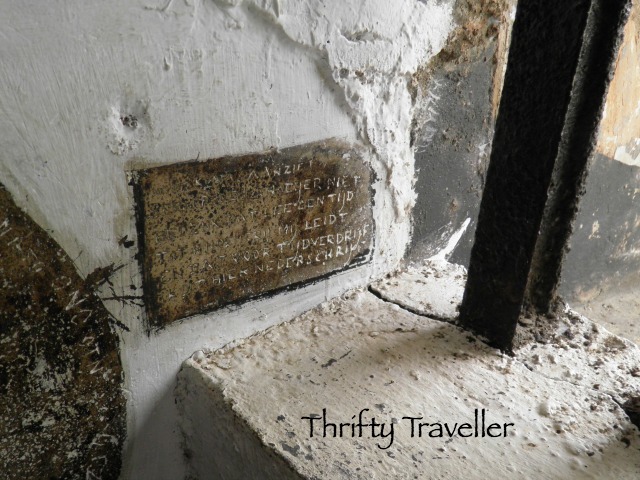
A piece of ancient graffiti has been carved into the wall of one of the former cells or barracks. Written in Dutch, presumably by a soldier or prisoner, it has been translated as “Whoever observes this compass, don’t get angry to the one who makes this scratching. Remember that the misery and time make me scratch here, and when I write this.”

Nice views from the walls of the fort.
Parr Memorial

A short distance from the fort is the Thomas Parr Memorial. Parr was the British Resident of Bencoolen, one of Raffles’ predecessors. He arrived in town in 1801 with instructions to cut costs, thereby alienating a lot of the locals who depended on EIC handouts, including his Bugis bodyguards. He was murdered and beheaded. The memorial looks rather shabby and serves as a skateboard park for the town’s youths but I suppose he is lucky to be remembered at all after all these years.
Hamilton Memorial
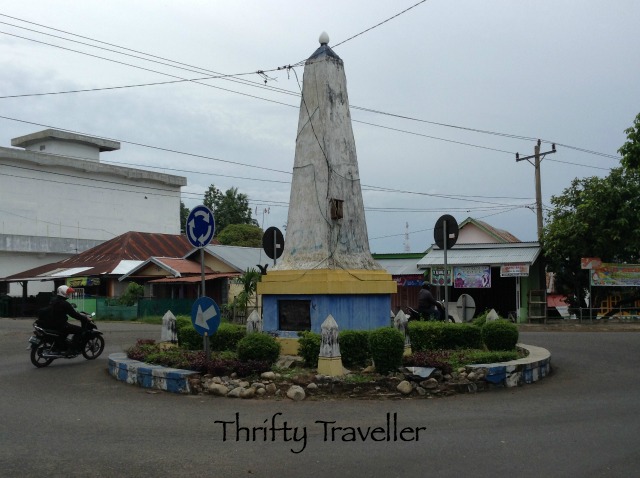
Another Brit has his own memorial, usefully serving as a traffic roundabout. The plaque on the memorial reads “Underneath this obelisk are interred the remains of Captain Robert Hamilton who died on the 15th December 1793 at the age of 38 years in Command of the Troops and Second Member of the Government.” Promotion in the EIC would have come fast In Bencoolen where disease was rife and long term survival prospects for the British inhabitants were bleak.
British Cemetery

Those Brits who succumbed to malaria, cholera, dysentery, small pox and the rest ended up here, the Makam Inggris tucked away in the back lanes next to a church. Hundreds would have been buried here over the centuries including Raffles’ four children but probably less than 50 graves are still visible. and many of these no longer have any inscription. After Bencoolen was handed over to the Dutch this became their cemetery in the same way as the Dutch Cemetery in Malacca became used by the British after the Dutch left.
Raffles’ Residence

This grand house in the heart of town is the Bengkulu Provincial Governor’s Residence. Some say that this was Raffles’ Residence which I suppose is a possibility allowing for a few renovations over the years. It is certainly the sort of location he would have chosen – very close to the fort and facing a padang, now used partly as a deer park and partly as a public space with a rather stunted and tatty modern observation tower in the middle.

Raffles built himself an idyllic country house called Permatang Balan at a place called Bukit Kabat (Hill of Mists) some 12 miles out of town. He retreated here with his wife and children and spent some of the happiest times of his whole life. Unfortunately I was unable to find out exactly where this house was and whether any traces still remain.

There is a spectacularly shaped hill close to Bengkulu, like Rio’s Sugarloaf Mountain, as shown in this photo taken from the Fort. Perhaps Raffles’ country house was in that direction.
Rafflesia Arnoldii

While Raffles was stationed in Bengkulu the giant, stinky parasitic flower now known as Rafflesia arnoldii was discovered in tropical forests near Lubuk Tapi. An excursion to visit the flower is one of the top things to do in Bengkulu but they only bloom in November/December so my timing was wrong.
Kampoeng China

In the shadow of the Fort is this gateway decorated with dragons marking the entrance to Kampoeng China.
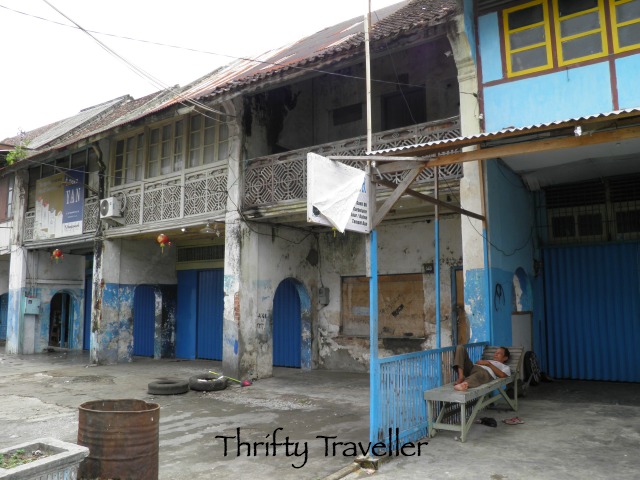
China Towns are often the most lively and bustling parts of any city in South East Asia but that does not appear to be the case here. Admittedly it was a hot Sunday afternoon but it seems in Bengkulu the centre of gravity has moved away from Kampoeng China to newer districts.
Bung Karno’s Residence

Soekarno (Sukarno), affectionately known as Bung Karno, was Indonesia’s first President and he led the country’s struggle for independence from the Dutch from the 1930s onwards. He was a thorn in the side of the Dutch and they exiled him, first to Flores and then to Bengkulu where he stayed in this house from 1938-1942. It is now a small museum and contains his well-thumbed book collection, his bicycle, his furniture and various photos and portraits
Ibu Fatmawati Soekarno House

In a nearby street is the house of Fatmawati who Sukarno met during his exile and later married.
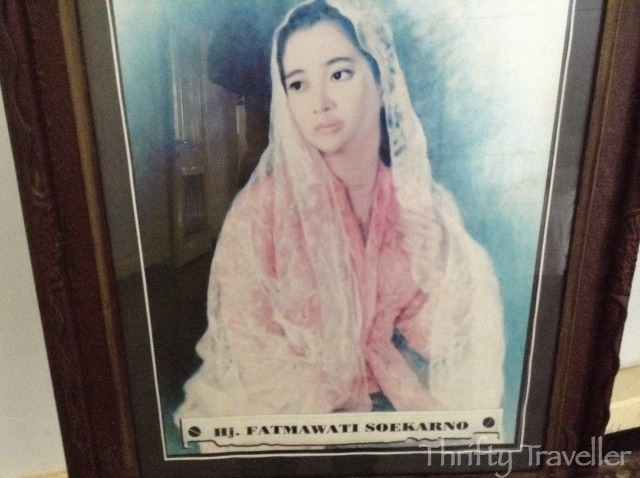
It is said that he was unable to attend his wedding ceremony so he sent along his dagger to represent him and she married that. Perhaps that explains her somewhat sad look in this picture. She is accredited with sewing the first Indonesian flag from two strips of red and white cloth and her sewing machine is one of the exhibits in the house.
Bung Karno Mosque

This mosque, also called Masjid Jamik, was remodelled under the guidance of Sukarno who was an architect among his many talents.
The Beach
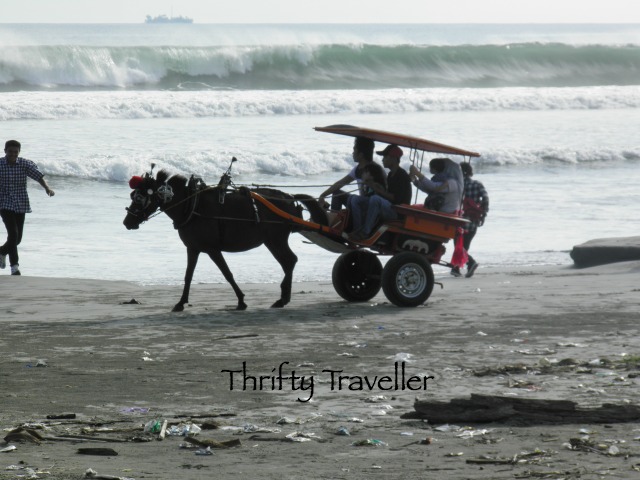
Bengkulu has a very pleasant beach called Pantai Panjang (Long Beach) stretching about 7km with a brick and concrete footpath running its entire length. Needless to say I walked from end to the other. I didn’t see anybody swimming. Dangerous currents perhaps?
On the horizon is Rat Island. It is the best place for snorkelling in this area.

I was excited to see a turtle on the beach but sadly, on closer inspection, it was dead.

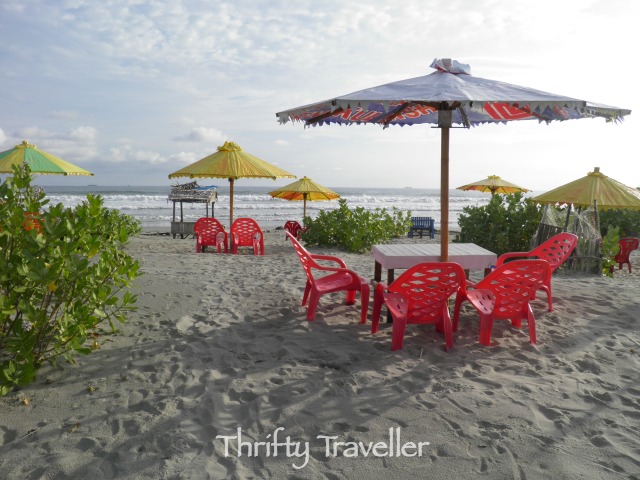
The beach is pretty empty in the heat of the day but gets busy with the locals in the early evenings who come to sip a coconut, have a meal or just enjoy the sunset and cooling breezes.
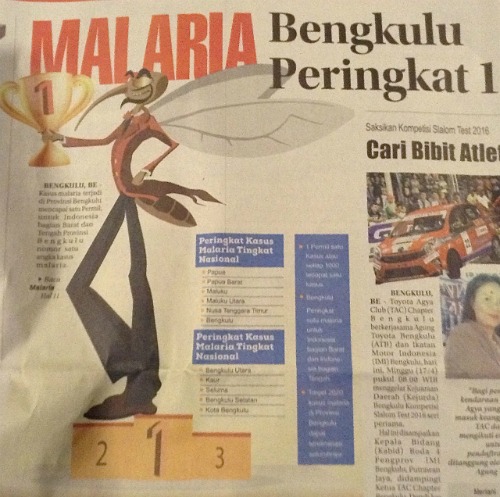
I hope I have not painted too negative a picture of Bengkulu. It has improved a lot since Raffles’ day. It is a nice place to visit and the people are super friendly. They need to do something about the malaria though. This newspaper headline while I was there says that Bengkulu tops the league table for malaria cases in Indonesia. Plenty of insect repellent required.

Interesting to see modern day Bengkulu. Yes Raffles spent far longer in Bencoolen than in Singapore where he was never at for longer than six continuous months. But what a legacy!
Very interesting, as usual 🙂
It’s also possible to identify the site of the original British headquarters, Fort York, though there’s nothing there actually to see. Here’s a piece I wrote a few years ago about it: http://jakartaglobe.beritasatu.com/archive/ghosts-of-britannia/
Hi Tim, thanks for that. I read your piece before my trip – it inspired me to go. I couldn’t find the exact site of Fort York on Google maps so I decided to concentrate on places that I could find.
fork york ada di daerah bukin pasar bengkulu dan kini diatas pemukiman penduduk pribumi